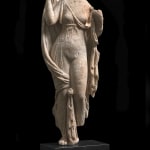Roman
A Roman marble statue of Venus Genetrix, circa 1st century BC
Marble
Height: 26.5 cm
Further images
The goddess standing with her weight on her right leg, the left relaxed, wearing a diaphanous chiton, belted at her waist, exposing her left breast and revealing the form of...
The goddess standing with her weight on her right leg, the left relaxed, wearing a diaphanous chiton, belted at her waist, exposing her left breast and revealing the form of her body beneath, and draped in a voluminous himation, pulled up behind her right shoulder and clasped in her upraised right hand, her left hand also upturned and once holding the now-missing apple, the excess drapery drawn around her right leg and amassed between her legs, the folds falling to the ground.
Condition:
Repaired across the middle with minor infill. Some surface wear and weathering including some chipping to the edges.
Condition:
Repaired across the middle with minor infill. Some surface wear and weathering including some chipping to the edges.
Provenance
Elsa Bloch-Diener (1922-2012) Collection, Bern, acquired before 1977Private collection, Switzerland
Literature
The Venus Genetrix sculptural type is based on a late 5th Century BC Greek bronze original by Kallimachos, recorded by Pliny in his Natural History. It depicted the goddess holding the apple won in the Judgement of Paris in her left hand, and lifting the edge of her himation with her right hand, in order to cover her head.The type is distinctive through her clinging drapery, which carefully reveals every curve of her body, and her posture which is between standing and walking. It is a clever combination of modesty and sensuousness, as the goddess is clothed and moving to veil herself, yet in doing so, she reveals a breast and the outline of her body.
The Venus Genetrix type was popularised in the early Julio-Claudian period, as Julius Caesar and his successor Augustus sought to identify with the goddess as progenitor of their family. Claiming direct descent from the goddess and Aeneas, Caesar built a temple to Venus Genetrix in his forum in Rome in 45 BC. For similar examples see nos. 225ff., pp. 25-27 in Delivorrias, et al., "Aphrodite" in LIMC.
For other examples, see the Metropolitan Museum, New York, acc. no. 32.11.3, and M. Bieber, Ancient Copies, New York, 1977, pl.23-26.







